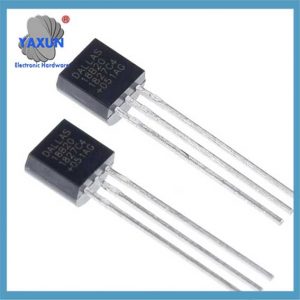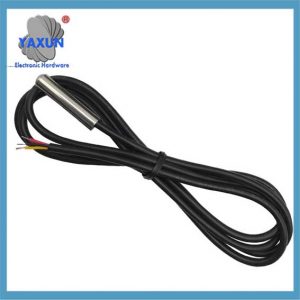We offer a wide range of the best 1-Wire DS18B20 sensor connectors, including Nanoflex, DisplayPort, USB, Solar, SATA, HDMI, ATA IDE, SAS & many more. All cables are manufactured to the highest industry standards. Using Sensor Circuit Assembly for box builds allows you to focus on your design and marketing, reduce costs, and reap the benefits of our assembly lines, QA processes, and manufacturing expertise.
El sensor DS18B20 se comunica mediante el “1-Cable” protocolo, lo que significa que utiliza una única línea de datos para todas las comunicaciones con un microcontrolador, permitiendo conectar múltiples sensores en la misma línea e identificarlos por su código de serie único de 64 bits; Esta única línea de datos se eleva con una resistencia y el sensor transmite datos bajando la línea durante intervalos de tiempo específicos para enviar bits de información..
Sensor de temperatura DS18B20: The DS18B20 waterproof probe is designed for underwater use, capable of operating in wet or moist environments without being damaged by water or moisture.
Temperature sensor supply voltage: 3.0V ~ 5.25V;
Rango de temperatura de funcionamiento:-55 ℃ +125 ℃ (-67 ℉ to +257 ℉);
Provides from 9-bit to 12-bit Celsius temperature measurements;
Adapter module is equipped with a pull-up resistor, and directly connects to the GPIO of the Raspberry Pi without an external resistor;
Use this adapter module kit to simplify connecting the waterproof temperature sensor to your project.
1. Key points about the 1-Wire protocol:
Single data line:
Only one wire is needed for communication between the sensor and the microcontroller.
Half-duplex communication:
Data can be sent in both directions, but only one direction at a time.
Parasite power:
The DS18B20 can be powered directly from the data line during communication, eliminating the need for a separate power supply in some cases.
Unique device addresses:
Each DS18B20 sensor has a unique 64-bit serial code that allows the microcontroller to identify and address individual sensors on the bus.
Communication steps with a DS18B20:
1.1 Reset pulse:
The microcontroller initiates communication by pulling the data line low for a specific duration (restablecer el pulso).
1.2 Presence pulse:
If a DS18B20 is present on the bus, it will respond with a short pulse, indicating its presence.
1.3 ROM command:
The microcontroller sends a ROM command to either read the unique 64-bit code of a specific sensor (“Match ROM”) or to address all sensors on the bus (“Buque”).
1.4 Function command:
Depending on the desired operation (like reading temperature), the microcontroller sends a specific function command to the sensor.
1.5 Data transfer:
Data is transmitted bit-by-bit, with the sensor pulling the data line low to send a ‘0’ and letting the line go high to send a ‘1’.
2. Explicación detallada del protocolo de comunicación de 1 cable de DS18B20
La razón por la cual los sensores DS18B20 se usan ampliamente se debe en gran medida a su protocolo de comunicación único. – 1-Protocolo de comunicación de cables. Este protocolo simplifica los requisitos para las conexiones de hardware y proporciona una forma eficiente de transmitir datos. Este capítulo analizará profundamente el mecanismo de trabajo y el proceso de intercambio de datos del protocolo de comunicación de 1 línea para sentar una base sólida para la práctica de programación posterior..
2.1 Conceptos básicos del protocolo de comunicación de 1 cable
2.1.1 Características del protocolo de comunicación de 1 alambre:
El protocolo de comunicación DS18B20 1 alambre también se llama “autobús único” tecnología. Tiene las siguientes características: – Comunicación de autobuses individuales: Solo se utiliza una línea de datos para la transmisión de datos bidireccionales, lo que reduce en gran medida la complejidad del cableado en comparación con el método tradicional de comunicación del sensor de múltiples alambres.. – Conexión múltiple: Admite conectar múltiples dispositivos en un bus de datos, e identifica y se comunica a través de códigos de identificación del dispositivo. – Bajo consumo de energía: Durante la comunicación, El dispositivo puede estar en un estado de espera de baja potencia cuando no participa en la comunicación. – Alta precisión: Con un tiempo de transmisión de datos más corto, Puede reducir la interferencia externa y mejorar la precisión de los datos.
2.1.2 Formato de datos y análisis de tiempo de comunicación de 1 alambre
El formato de datos del protocolo de comunicación de 1 cable sigue una regla de tiempo específica. Incluye el tiempo de inicialización, Escribir tiempo y leer el tiempo:
Tiempo de inicialización: El huésped inicia la primera vez el tiempo de detección de presencia (Pulso de presencia) bajando por el autobús por un cierto período de tiempo, y el sensor luego envía un pulso de presencia en respuesta.
Escribir el tiempo: Cuando el anfitrión envía un tiempo de escritura, Primero baja el autobús por aproximadamente 1-15 microsegundos, Luego libera el autobús, y el sensor baja el autobús 60-120 microsegundos para responder.
Leer Tiempo: El host notifica que el sensor envía datos retirando el autobús y liberándolo, y el sensor emitirá la broca de datos en el bus después de un cierto retraso.
2.2 Software implementation of data communication
2.2.1 Initialization and reset of 1-line communication
At the software level, initialization and reset of 1-Wire communication is the first step of communication. The following is the pseudo code to implement this process:
// OneWire communication initialization function
void OneWire_Init() {
// Set the bus to input mode and enable the pull-up resistor
SetPinMode(DS18B20_PIN, INPUT_PULLUP);
// Wait for the bus to be idle
DelayMicroseconds(1);
// Send a reset pulse
OneWire_Reset();
}
// OneWire communication reset function
void OneWire_Reset() {
// Pull down the bus
SetPinMode(DS18B20_PIN, OUTPUT_LOW);
DelayMicroseconds(480);
// Release the bus
SetPinMode(DS18B20_PIN, INPUT_PULLUP);
DelayMicroseconds(70);
// Wait for the presence of a pulse
si (!WaitForOneWirePresence())
// No pulse was detected, maybe the sensor is not connected or the initialization failed
HandleError();
DelayMicroseconds(410);
}
// Waiting for the presence of a pulse
bool WaitForOneWirePresence() {
return ReadPin(DS18B20_PIN) == 0; // Assume low level is a signal presence
}
2.2.2 Data reading and writing operations
Data reading and writing operations are the core part of sensor communication. The following code shows how to write a byte to a one-wire bus:
// Write a byte to a one-wire bus
void OneWire_WriteByte(byte data) {
para (int i = 0; i < 8; yo ++) {
OneWire_WriteBit(datos & 0x01);
datos >>= 1;
}
}
// Write a bit to a one-wire bus
void OneWire_WriteBit(bit data) {
SetPinMode(DS18B20_PIN, OUTPUT_LOW);
si (datos) {
// Release the bus when writing 1
SetPinMode(DS18B20_PIN, INPUT_PULLUP);
DelayMicroseconds(1);
} demás {
// Continue to pull the bus low when writing 0
DelayMicroseconds(60);
}
SetPinMode(DS18B20_PIN, INPUT_PULLUP);
DelayMicroseconds(1);
}
Next is the function to read a byte:
// Read a byte from the one-wire bus
byte OneWire_ReadByte() {
byte data = 0;
para (int i = 0; i < 8; yo ++) {
datos >>= 1;
si (OneWire_ReadBit())
datos |= 0x80;
}
return data;
}
// Read a bit from the one-wire bus
bit OneWire_ReadBit() {
SetPinMode(DS18B20_PIN, OUTPUT_LOW);
SetPinMode(DS18B20_PIN, INPUT_PULLUP);
DelayMicroseconds(3);
bool result = ReadPin(DS18B20_PIN);
DelayMicroseconds(57);
return result;
}
2.2.3 Verification mechanism of OneWire communication
The OneWire communication protocol uses a simple verification mechanism in the data exchange process, usually by reading back the written data to verify the correctness of the data. The following is a sample code for verifying the written data:
byte data = 0x55; // Assume that the data to be sent
OneWire_WriteByte(datos); // Write data to the OneWire bus
byte readData = OneWire_ReadByte(); // Read back data from the OneWire bus
si (readData != data) {
HandleError(); // If the read-back data does not match the written data, handle the error
 English
English Afrikaans
Afrikaans العربية
العربية বাংলা
বাংলা bosanski jezik
bosanski jezik Български
Български Català
Català 粤语
粤语 中文(简体)
中文(简体) 中文(漢字)
中文(漢字) Hrvatski
Hrvatski Čeština
Čeština Nederlands
Nederlands Eesti keel
Eesti keel Suomi
Suomi Français
Français Deutsch
Deutsch Ελληνικά
Ελληνικά हिन्दी; हिंदी
हिन्दी; हिंदी Magyar
Magyar Bahasa Indonesia
Bahasa Indonesia Italiano
Italiano 日本語
日本語 한국어
한국어 Latviešu valoda
Latviešu valoda Lietuvių kalba
Lietuvių kalba македонски јазик
македонски јазик Bahasa Melayu
Bahasa Melayu Norsk
Norsk پارسی
پارسی Polski
Polski Português
Português Română
Română Русский
Русский Cрпски језик
Cрпски језик Slovenčina
Slovenčina Slovenščina
Slovenščina Español
Español Svenska
Svenska ภาษาไทย
ภาษาไทย Türkçe
Türkçe Українська
Українська اردو
اردو Tiếng Việt
Tiếng Việt






